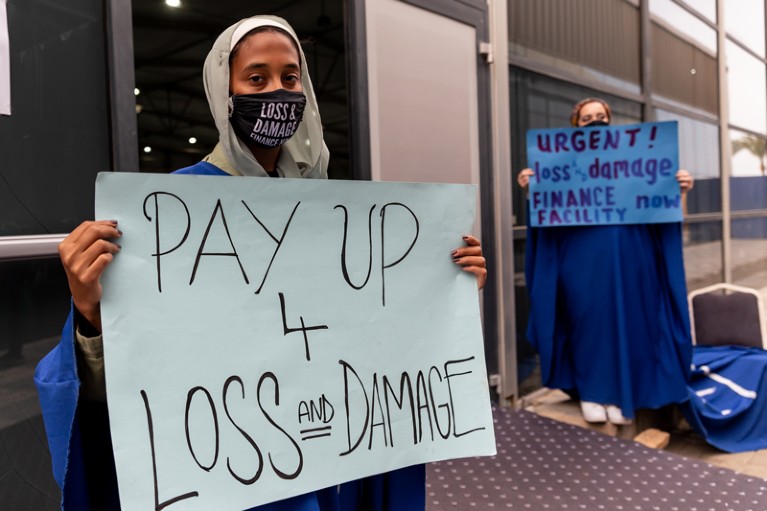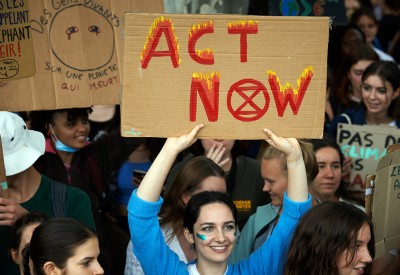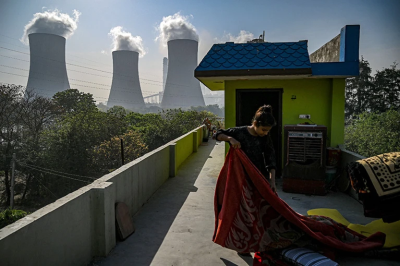
Agreement was finally reached at COP27 to create a fund to compensate climate ‘loss and damage’.Credit: Dominika Zarzycka/NurPhoto/Getty
COP27, the 27th Conference of the Parties to the United Nations Framework Convention on Climate Change (UNFCCC) in Sharm El-Sheikh, Egypt, broke up at dawn on 20 November. The final communiqué came just hours before the football World Cup kicked off in Qatar, continuing a time-honoured tradition of these summits going into extra time before any sort of result is achieved.
In many other respects, the meeting had a depressingly familiar feel to it, too. Delegates reaffirmed their commitment to the goal of the 2015 Paris climate agreement — to limit global warming to 1.5 °C above pre-industrial temperatures — while making no further commitments to phase out fossil fuels. This is a shocking dereliction of duty. For warming to be limited to 1.5 °C, emissions need to fall by 45% from 2010 levels by 2030. According to the latest UNFCCC report, published in October, they are set to increase by more than 10%. There is still no coordinated plan to turn these figures around. With some 45,000 people registered to attend COP27 — a record — many are questioning whether a planetary emergency can be tackled in this way.
One undoubted step forwards, however, came with the historic agreement to create a ‘loss and damage’ fund. For the first time, countries that have suffered devastation as a result of climate change will be helped with the associated costs, such as those of rebuilding homes and businesses destroyed by floods. This represents a totally new kind of fund, going beyond existing (if imperfectly implemented) mechanisms for funding the costs of mitigating and adapting to the effects of climate change.

COP27 climate summit: what scientists are watching
It’s taken three decades to get to this point, at least in part because of arguments between richer and poorer countries on a whole raft of issues. These range from a lack of agreed definitions on what constitutes climate finance to a fear on the part of richer countries that they could end up liable for trillions of dollars in loss-and-damage payments.
Arguments over money resurface at every COP. Doubtless they will return at COP28, which is due to be held in Dubai in the United Arab Emirates in a year’s time. The size of the loss-and-damage fund, who will contribute and which countries will benefit are all yet to be discussed.
To help settle at least some points of disagreement, a group of climate-vulnerable countries will be asking the Intergovernmental Panel on Climate Change (IPCC) to assemble an expert synthesis of the relevant scientific literature on loss and damage, and to publish its findings in a special report. This will help negotiators to tackle questions such as what is meant by loss and damage from climate change, and to what extent individual events can be attributed to climate change.
This is an excellent idea, not least because it will help to establish areas in which experts largely agree — or disagree — and so identify instances in which further research could help to unpick outstanding questions. But it doesn’t go far enough. The IPCC should also prepare an evidence synthesis on climate finance itself. The lack of such a synthesis means that even the most basic concepts and methodologies are disputed, says Romain Weikmans, a researcher at the Université Libre de Bruxelles, who is one of those pushing the IPCC to take on this task. It’s not just loss and damage: the ins and outs of mitigation and adaptation finance are also still hotly disputed.
Donor countries, for example, count money that has been pledged or promised, say for investment in flood defences or wind energy. But low- and middle-income countries (LMICs) would prefer to count only money that has actually been received by projects on the ground, often a much smaller amount. Donors also count loans — which account for the lion’s share of climate finance — whereas LMICs would prefer to count only grants or other money that does not have to be repaid. Then there’s the question of scope. If a new housing development in an area of high temperatures is fitted with special cool roofs, say, some would like to count the whole development as climate finance, whereas others would say just the roof part qualifies.

Carbon emissions hit new high: warning from COP27
Questions surrounding climate finance are not going to go away. Many are clearly political, and need to be decided at a COP by government negotiators. Those negotiators would benefit enormously if the research community could set out options to inform their positions, and provide a sense of the balance of agreement and disagreement around those options.
The IPCC has performed such a role before, Weikmans points out. In 1998, it established an expert task force on accounting for greenhouse-gas emissions, to bring consistency to an array of different national methodologies. Before that, in 1995, it assessed the literature on whether humans are causing climate change, agreeing the now famous phrase: “The balance of evidence suggests a discernible human influence on global climate.” That settled a long-running argument among scientists and governments, and paved the way for the 1997 Kyoto Protocol, the first legally binding agreement made with the aim of reducing greenhouse-gas emissions.
The way the IPCC is set up means that if governments want its advice, they must make a formal request. That request is now overdue. Blutus Mbambi, co-founder of the Centre for Climate Change Action and Advocacy in Lusaka, Zambia, tells Nature that it was shocking to see how long negotiators in Sharm El-Sheikh spent in debates over the text, and how little evidence they had before them to make their decisions. Research must start getting match fit now, before the next round in Dubai.
from WordPress https://ift.tt/qszTgtn
via IFTTT